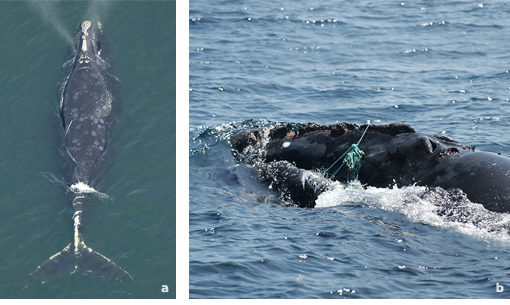


Humans have long been responding to animals in distress and that certainly describes a whale entangled in fishing gear, be it lines or nets. Entanglements can be fatal for right whales. Between 1986 and 2006, 39 right whale carcasses were necropsied along the eastern seaboard of Canada and the United States. Of those, at least six were determine to have died from entanglement in fishing gear. Twelve other right whales last seen entangled and in poor health have not been seen since. An examination of photographs has shown that 75% of known right whales have been entangled at least once 1 . Although many entangled right whales are eventually able to shed the gear, some suffer a slow and painful death as entangling lines slice into their skin and bone, this is especially true of fishing lines wrapped around the flipper of a still growing juveniles.

a) Aerial view of a North Atlantic right whale showing white entanglement scars on the peduncle (tail stock) and flukes. b) Piper was first seen in 1993 and at the time was already at least two years old. She had been entangled twice in a 12-year period, but was seen in April 2005 free of gear.
In an attempt to disentangle right whales, emergency networks have been established throughout the range of the right whale along the east coast of Canada and the United States. The response to an entangled whale by network members is coordinated by the Provincetown Center for Coastal Studies who provides logistic and financial support to disentanglement efforts. To release whales from fishing gear, trained rescue teams use a combination of old whaling methods to slow down the whales (kegging, attaching floats to trailing lines on the whale), and modern technologies to track them (satellite telemetry). But even with extensive efforts, sometimes over a period of months, rescuers are only successful at freeing about 50% of entangled right whales. Many more entangled right whales go unreported. Measures to prevent right whales from becoming entangled in the first place such as area closures, sinking ground lines, weak links and others have been implemented in some areas of the United States, but not across the complete range of species.
Contact information of the emergency networks in Canada can be found on the Emergency page.
Timeline

